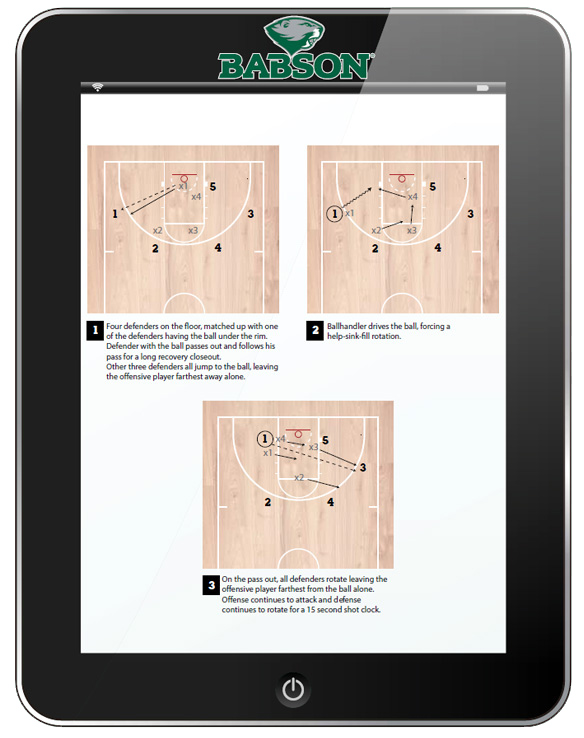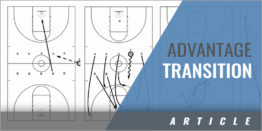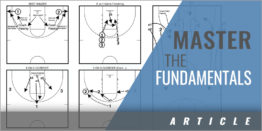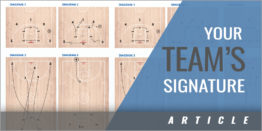| 5 on 4 Scramble |
| By: Stephen Brennan - Head Coach • Babson College
Originally Published in: Time-Out Magazine Provided by: National Association of Basketball Coaches We use 5 on 4 Scramble with a 15-second shot clock to work on long recovery closeouts driving shooters off the arc; to alert help defenders EARLY to anticipate where their next defensive responsibility is through simple one word communication; to execute help-sink-fill responsibilities; and to complete plays with contests and block outs. Defensively our goal is to make the offense make more passes to generate field goal attempts and to reinforce our core defensive concepts to communicate- contest-block out to get defensive stops. Although our focus is defensive, we also coach the offense to work together to attack the defense and create the best shot with extra passes and crisp ball movement. We continually emphasize that "the pass makes the shot," a Doc Rivers quotation. 1. The four defenders on the floor match up and one of the defenders has the ball under the rim. The defender with the ball, X1, passes to offensive player #1 and follows his pass for a long recovery closeout. As X1 executes the closeout, we teach X1 to communicate EARLY "help" or "stay." If the other three defenders, X2-X3-X4, hear "stay" they will remain in their current help positions. If they hear "help" they are rotating to attack the dribble penetration outside the lane, protecting the rim and leaving the furthest offensive player open. We move the defender who executes the long recovery closeout to different spaces on the floor to get repetitions versus baseline, wing and slot dribble penetration. In terms of the closeout, we force sideline/baseline closeout with two hands up, and the closeout defender must be loud with the "help or stay" call. We use one word communication to keep it simple and have found it more effective than phrases. The other defensive issue is accounting for offensive player #5 who we can use to pin screen help defenders, move along the baseline to be a scorer off dribble penetration, or create a 5-out perimeter alignment which forces greater communication among the four defensive players. 2. On the pass to offensive player #1, we generate both middle and baseline bounce dribble penetration and can play it "live," how #1 reads and attacks X1, or we can choreograph it to work on either middle or baseline bounce. Offensive player #5 is critical to account for when he moves along the baseline and in the early season repetitions, defenders often fail to account for him as the defenders get locked in on the perimeter match ups, failing to realize that their responsibilities change, similar to defending transition. Defensive players often forget that we must play the percentages and we talk about protecting the basket vs. forcing another pass out to the perimeter. Good defensive sequences force those extra passes and can also create shot clock violations. We do not allow the defense to zone the situation. As the ball moves via the pass or dribble, the defense must recognize which offensive player is furthest away and leave him open, protect the paint by stopping the bounce outside the lane, and execute help-sink-fill jobs. 3. On the pass out from offensive player #1 to #3, all defenders rotate leaving the offensive player farthest from the ball alone. The offense continues to attack and the defense continues to rotate for a 15-second shot clock. We will keep score for stops for a five to 10 minute period with a penalty for the losing team or we can keep traditional scoring and work on our late clock offense and allow the scoring team to stay on offense.  
The 2017 NABC Division III Coach of the Year, Stephen Brennan led Babson College to the 2017 NCAA Division III championship. The Beavers had a 31-2 won-lost record and tipped Augustana (Ill.) 79-78 in the title game in Salem, VA. A nine-time conference coach of the year, Brennan is in his 22nd year as Babson’s head coach with four consecutive NCAA tournament appearances, including two berths in the Division III Final Four. |






